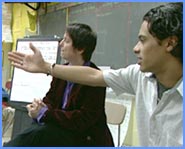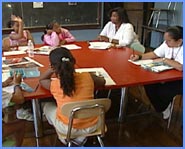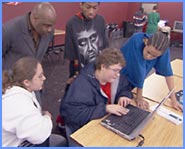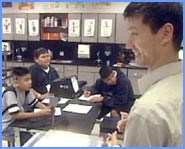The Afterschool Training Toolkit is designed to give afterschool program directors and instructors the resources they need to build fun, innovative, and academically enriching activities that not only engage students, but also extend their knowledge in new ways and increase academic achievement. The purpose of this section is to demonstrate different ways to use this toolkit to promote staff development and support collegial learning.
Getting Started
Staff training and on-going professional development is key to implementing effective afterschool programs. However, it's not always easy to find the time to work with staff on specific issues. But whether you have a two-day training with staff, or just 15 – 30 minutes once a week, you can use the Afterschool Training Toolkit to help your staff to improve their work with students and support academic success.
10 Ways to Use this Toolkit provides a step-by-step model for conducting professional development. Through it, staff will be encouraged to learn about the resources in the Afterschool Training Toolkit, reflect on their current practice, and try new approaches to teaching. The steps are sequential and build upon each other.
Phase One - Create Awareness
Goal: Create awareness of new concepts and ideas, and provide resources for learning about them.1) Introduce the Toolkit and Academic Enrichment (15 minutes)
- Show your staff the Afterschool Training Toolkit Web site.
- Explain and demonstrate as you click through the pull-down menu on the Homepage that there are four to six "promising practices" for each content area.
- Explain that the promising practices are methods of embedding academic content into enrichment activities.
- Inform them of your intention to begin staff development on promising practices to improve student learning and solicit their general concerns.
- Invite staff to explore the toolkit on their own and/or schedule another session to introduce and discuss a specific practice.
2) Introduce a Practice Using a Video (30 minutes)
- Watch a video with staff on a selected practice in the toolkit.
- Discuss and facilitate recognition of key elements of the practice. Use these suggested questions to guide your discussion:
- What impressed you most about the video?
- How is this similar to or different from your current afterschool practice?
- What skills or concepts were being worked on?
- What kinds of strategies did you notice being used?
- Student engagement
- Student grouping
- Content integration
- Classroom management
- What else do you need to know to successfully implement this practice?
- Based on the video, do you have other comments or questions about ways to use this practice in your enrichment activities?
- Review the difference between a "practice" and a "lesson" or "activity."
3) Introduce a Practice Through Reading (15 minutes)
- Provide staff with a printed copy of a selected practice page or ask them to read it online.
- Discuss the following:
- What is the content goal? (The key content goal is located in the upper left box of the practice page)
- What is it? (Located in the first paragraph under the Practice in Action tab)
- Compare the information with your current practice.
Phase Two – Build Understanding
Goal: Expand knowledge and understanding of key ideas and concepts of a chosen topic.4) Learn the Theory Behind a Practice (15 minutes)
- Provide staff with a printed copy of a selected practice page or ask them to read it online.
- Discuss the last two sections of the Practice in Action tab:
- What do I do?
- Why does it work?
- Compare the information with your current practice.
5) Examine a Sample Lesson (15 minutes)
- Look at a Sample Lesson for a selected practice in the toolkit.
- Discuss the parts of the sample lesson or activity.
- Compare the sample with lessons or activities instructors are currently using.
- Discuss possibilities for improving an existing activity or creating a new one based on this model.
Phase Three – Make Decisions
Goal: Assess needs and decide how to incorporate new knowledge into current practice.6) Choose a Practice (30 minutes)
- Convene staff to discuss academic enrichment priorities in view of program goals and student needs.
- Explore the selected content area of the toolkit and identify a promising practice on which to focus.
- Decide how the practice can be utilized in enrichment activities. Look at the Sample Lessons for ideas.
- Assign staff to work as a team to develop an activity idea based on the selected practice.
- Ask staff to follow the Planning Your Lesson guidelines and use the Lesson Planning Template to develop their activity.
Phase 4 – Plan and Prepare
Goal: Plan and prepare to implement a practice based on new knowledge.7) Develop an Activity (30 minutes)
- Ask staff to consider the activity they developed with in their team. Ask: "What academic skills does the activity target?"
- Allow the group to discuss their needs. Ask, "What would you need to be able to implement your activity?" Site coordinators should take notes and expect some of these possible needs, for example: books, paper, markers, maps, computer.
- Responses may indicate a need for more knowledge or rehearsal in order to conduct the activity appropriately. If so, plan to review the promising practice as needed and allow for role-play rehearsal of the activity itself. (See 4. Learn the Theory Behind a Practice, above, and 8. Rehearse a Planned Activity, below.)
- If the responses indicate that your staff needs more time to develop the activity, schedule another planning meeting after the team has had time to work together again.
8) Rehearse a Planned Activity (30 minutes)
- Have your staff come prepared to rehearse implementation of the activity through role-play with their teammates.
- Facilitate a discussion as teammates debrief their learning experiences. Ask:
- What went well?
- What needs more work?
- What else do you need to think about before you do this with the kids?
- Remind them to be mindful of student engagement as they actually deliver the activity with students and to jot down notes for discussion at a follow-up session for reflection and sharing.
Phase 5 - Reflect and Refine
Goal: Reflect on implementation and improve, refine, or extend the activity.9) Reflect on Instruction (30 minutes)
- Have instructors discuss their experiences of implementing the activity with students. Remind them to draw on notes they may have taken during and after.
- During the discussion, ask:
- What went well?
- What needs work?
- What did the students do during the activity?
- How did this activity help you build your understanding of the practice?
- How did the activity help students build the targeted academic skills?
- Following the debriefing with instructors, engage all staff in a discussion about ways that everyone can work together to improve implementation of the practice. Ask:
- What do you need to do or modify before conducting the activity again?
- How can we help each other become better at this practice?
- What other activities might we create utilizing this practice?
Phase 6: Extend Learning
Goal: Explore additional resources to build on knowledge gained through recent experience.10) Explore Additional Resources (15 minutes)
- Have staff think about ways to extend their knowledge about the practice they have been implementing by looking at the Resources tab on the Practice page. Invite them to create variations of the activity or a new activity based on other examples they may find.
- Have staff work in pairs or as a group to review standards related to the given content area and have them think again about how the practice promotes skills related to expectations for students.
- Allow staff to learn more about the content area overall using the Resources page.
- Ask staff to make suggestions on what other practices would compliment and support what they have already begun.
Now that you have gone through a practice (by watching a video vignette of it in action, viewing sample lessons, and creating and testing some activities of your own) we invite you to go through this process again. Each time you work on implementing a specific practice, you will find that this effort will build the knowledge and skills of your afterschool staff. This, in turn, will help staff to implement fun and engaging activities that supports academic enrichment for your students in afterschool.
10 Ways to Use this Toolkit for Professional Development ©2009 SEDL




